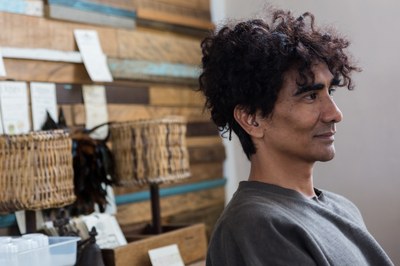
攝影 |張震洲
《阿棲睞》
布拉瑞揚舞團
首演日期│2016/05/14
首演地點│國家表演藝術中心國家兩廳院國家戲劇院
入圍理由
2016年布拉瑞揚推出的兩部舞作《阿棲睞》與《漂亮漂亮》,都受到本屆觀察提名委員的青睞,在討論過程中,兩部作品都各有強烈支持,形成了自己與自己的對決,一直到了最後一輪投票,《阿棲睞》終於勝出。《漂亮漂亮》感人討喜,視覺效果令人驚豔,但是《阿棲睞》在感人之外,震撼力道更勝一籌,並且挑戰了舞蹈的概念,以一再重覆的高度體能動作,讓舞者身體在一次一次的筋疲力竭中所產生的線條與節奏變化,配合同樣聲嘶力竭的吟唱,最後讓整部舞蹈形成一氣呵成的張力與完整!以此編舞概念來闡述原住民與大地的合而為一,兼具哲學與美學上的意涵,為生存而舞蹈,因舞蹈而感覺存在,兩者迴旋激盪出「斜坡上的石頭」(「阿棲睞」一詞原意)的雄壯與真情,令人屏息動容。(主筆/郭強生)
關於《阿棲睞》
「阿棲睞 Qaciljay」為排灣語音譯,表石頭之意,更隱含台灣東岸原鄉居住地景,座落於斜坡上的石頭。《阿棲睞 Qaciljay》以「山」為題目出發,並向部落學習傳統歌舞,也將舞者置入環境當中藉由「勞動」學習並累積。此為舞團第二號作品,學習傳統歌舞是舞團訓練中重要的一環,製作期間多次田野調查、訪問排灣族知識傳承者以深化舞作內涵,也立下未來創作可循的規則與方法。 2014年布拉瑞揚舞團成立於台東,聚焦於在地連結與文化涵養,由創團作品《拉歌 La Song》便邀請大量臺灣東部原住民青年表演者加入。《阿棲睞 Qaciljay》的開端,布拉瑞揚即帶著舞者回到自己的故鄉嘉蘭部落,向部落長者學習整地、收生薑,藉由勞動而涵養舞者的身體,期許舞者不只獲得技巧上的增進,而是熟成「成為人」的過程。
關於人物
2014年,排灣族編舞家布拉瑞揚・帕格勒法於故鄉台東成立「布拉瑞揚舞團」,將焦點放在台東在地生活,自傳統文化與人文地景取材,將東岸豐富的人文地景收納進舞者身體當中。創團作《拉歌 La Song》半數以上舞者為東部原住民青年,扎實的歌舞訓練及田野調查,成果非凡;2016年作品《阿棲睞 Qaciljay》則取排灣族語「石頭」之意涵,隱含台灣東岸原住民居住地景,並帶領舞者回到布拉瑞揚的故鄉嘉蘭部落,向長者學習整地、收薑等勞動技藝,不只增進舞者表演技巧,更重要的是,透過將個體融入群體之部落儀式,經歷「成為一個人」的個體熟成過程。
出身雲門舞集的布拉瑞揚,作為舞者,在台上光彩奪目,眾人折服;作為編舞家,他曾受邀為世界知名的瑪莎•葛蘭姆舞團(Martha Graham Dance Company)編舞,頗有好評,國內外編舞邀約不斷。他本可留在國外、在資源豐富的情況下專心創作,卻毅然回到故鄉台東成立舞團,眾人說他一時衝動,其實內心早已醞釀三年。在紐約為瑪莎・葛蘭姆舞團編舞時,布拉瑞揚就想成立自己的舞團,給熱愛表演的原住民青年更多機會,「跳舞這麼多年,爸媽卻好像始終不了解我在做什麼,甚至有故鄉的親友以為我是去學綜藝節目的伴舞,問我『怎麼還沒上電視?』」有人期許登上國家劇院,有人冀望巡迴世界各大廳堂,布拉瑞揚自問屬於他的殿堂在哪?「我想給父母看看我這幾年到底在做什麼,家鄉就是我的殿堂。」
自幼離家,布拉瑞揚對家鄉其實非常陌生,「我以前回台東,待沒幾天就急著想上台北,部落太無聊了,待不住。朋友一聽我要回台東成立舞團,都說我那麼都市化的一個人,一定待不到半年就想回台北。」他本來也想在台北創團,但台北要去哪找原住民舞者?在寸土寸金的台北市哪有舞團訓練場地?友人聽聞布拉瑞揚想創團,熱情介紹他回台東看糖廠倉庫,「我一看,四面黑色牆壁加上挑高天花板,這就是我要的!本來去台東只帶了一個背包,打算待三天就走,結果車票一延再延,我才發現原來從場勘那天起,我就沒再想過回台北了。」
「我只是想創造一個空間,讓原住民孩子及家長可以看見未來有更多元的選擇,讓每個人都有機會來這跳舞。朋友開玩笑說我怎麼打掃倉庫把自己弄得又髒又黑?但我覺得現在的我很單純,很踏實。或許,以前我都在裝扮自己求取認可,現在這個才是真正的我。」不喜歡受注目的他,本來只想低調創團創作,沒想到一說要成立舞團,大家都來出錢出力,「原來成立舞團不只是布拉瑞揚的事,是大家真的期待台東有這樣的空間很久了。我是有責任的,也終於明白這決定是正確的。雖然很多事仍邊做邊學,但回來的時間點不早也不晚,祖靈都安排好了。」
高中到高雄讀書學舞,全校就他一位原住民,旁人始終投以特別注目。高一某天放學,途經旅館一位男子問他是不是山地人?然後指向旅館門後說這裡有山地姑娘,要不要進來?「我當時真的很自卑,原住民怎麼會是這樣!我很幸運從舞蹈得到抒發和慰藉。直到去紐約我才知道,原來世界上有各種膚色的人,各種各樣的歧視;原來我不差,我不需要自卑。」布拉瑞揚鼓勵身邊舞者出國旅讀,成立舞團也特別照顧原民青年舞者。「出去看看才知道自己是誰,知道自己要往哪裡去。」
若非在台東與原民舞者工作,布拉瑞揚可能仍會因循過往的排練方法;「出國」讓他看見自己,但是「回家」才讓他成為自己。「以前林懷民老師常說我太慢、不積極,在台東我卻常被舞者說太急了。因為許多舞者不是科班出身,我習慣用的語彙他們一時無法瞭解,卻也因為這樣,我們採用了移地訓練的方式,帶舞者上山下海,去部落做身體訓練。我慢慢發現許多事不用刻意強求,自然而然就好。」即使結果並非最好,但不疾不徐,過程本就需要時間醞釀。
《阿棲睞》從部落儀式中常見的「牽手」出發,不僅舞者彼此牽手,也和觀眾、和故鄉的鄉親牽手,這是一趟始終在路上的旅程,並不因演出結束而告一段落。結束劇院的演出,布拉瑞揚帶舞團至台灣東部進行部落巡演,未來還有更多的作品會在台東或部落進行首演。「雖然出生台東,但至今我仍不覺得自己是真正的台東人,就創作上來說,我可能要花一輩子尋找自己。可以確定的是,我應該不會再離開台東了,這裡有太多可以學習、可以分享的事。」

布拉瑞揚舞團
成立於2014年,受羅曼菲舞蹈獎助金支持,由台灣原住民編舞家布拉瑞揚‧帕格勒法創立。在過去的二十年中,布拉瑞揚多次受邀為國內外許多舞團編舞並演出。儘管如此,當他意識到自己身為原住民、也是一個排灣族人時,「認同」的過程引領了他往原住民文化的路上前進,並開啟了一段新旅程。他決定回到家鄉,並建立了自己的舞團,為了與有才華的原住民青年工作,不僅可以跳舞,更有令人驚艷的歌聲,這也是布拉瑞揚舞團最重要且不同於一般現代舞團的特質,藉由文化上的田野調查,更深入的去看見文化裡頭蘊含的內在,發展屬於原住民特有的身體表述和語彙。成立舞團,是要將原住民的孩子以及舞團作品帶到國際上,分享給更多的觀眾。
作品相關評論
直視行動,在歷史中《阿棲睞》─表演藝術平台2016/05/20
朱宗慶/阿棲睞—用生命去經營─udn / 評論 / 聯合報名人堂2016/05/19
青春,既暴烈又溫柔---王嘉明的《七》與布拉瑞揚的《阿棲睞》─ARTALKS2016/07/06
製作團隊
藝術總監暨編舞│布拉瑞揚‧帕格勒法
音樂設計│陳主惠
燈光設計│李建常
服裝設計│林秉豪
影像繪圖作者│撒古流
影像協力製作│亞粟・亞巫
現場演唱歌者│林廣財
排練助理│黃韋捷
舞者│林定、黃韋捷、許培根、張堅志、洪琮智、周堉睿、曾永傑、曾志浩、謝昊穎、陳忠仁
行政執行│林定、薛紹君
--------------------------------------------------------------------------------------------------------------------------------------------------------
Qaciljay
Bulareyaung Dance Company
Comments from Nomination Committee
The two works that Bulareyaung presented in 2016, Qaciljay and Colors, have both won the praises of the nomination committee members this year. During the discussion, both works have been strongly supported by different members as well, making the two works each other's rivals. Eventually, Qaciljay won in the last round of voting. While Colors is touching and approachable with its stunning visual presentation, Qaciljay is not only touching but also possesses a more impactful force. It challenges the concept of dance and adopts repetitive, physically demanding movements, creating the work's tension and completeness in one go by integrating the variations of line and rhythm produced by the dancers' bodies through repeated, exhausting movements and roaring chanting. The choreographic concept of the dance illustrates the union of the indigenous people and the earth, embodying both philosophical and aesthetic significance. They dance to survive, and own that sense of being alive because of dancing. Both forces collide and create the magnificence and true emotions of "the stone on the slope" (the meaning of "qaciljay"), making the work genuinely moving and breath-taking. (Commentator: KUO Chiang-Sheng )
About the Artwork
"Qaciljay" means stones in Paiwan language, which also refers to the landscape of indigenous villages in eastern Taiwan – the stones that sit on the slope. Qaciljay is a topic based on mountains. The dancers not only learned traditional songs and dances from the tribal community, they were also put into the environment to learn and accumulate experience through laboring. Qaciljay is the second project of Bulareyaung Dance Company. As learning traditional songs and dances is a very important part of the training in the dance company, their dancers conducted many field studies and interviewed tribespeople who have inherited great knowledge of Paiwan culture during the production period. This endeavor deepened the content of the dance piece and also set up a feasible rule and method for future creations.
Since its establishment in Taitung in 2014, Bulareyaung Dance Company has focused on local connection and cultural cultivation. As a result, in the dance company's first project La Song, half of the performers were indigenous youths from eastern Taiwan. In the beginning of Qaciljay, Bulareyaung brought the dancers back to their hometown, Buliblosan community. They went back to the mountains to learn from the tribal elders how to prepare soil for planting and how to harvest ginger in order to cultivate their bodies through laboring. It was not only an improvement of techniques but also a process of becoming a more mature person.
About the Artist
Bulareyaung Dance Company was founded in 2014 by Taiwan’s indigenous choreographer Bulareyaung Pagarlava (aka “Bula”) in Taiwan. During the last two decades, Bula has been invited on numerous occasions to choreograph and perform for various contemporary dance companies both at home and abroad. However, his increasing awareness of his Paiwan identity has led him onto a new path. He decided to return to his hometown and established his own dance company to work with talented indigenous youths, who not only can dance, but also have stunning voices, an important characteristic of this company that sets them apart from other modern dance companies. Through researching his own culture in greater depth with his own people, they have developed their unique bodily expressions characteristic of the indigenous culture. Bula’s aim is to showcase his works performed by the indigenous company for a wider audience on the global stage.
